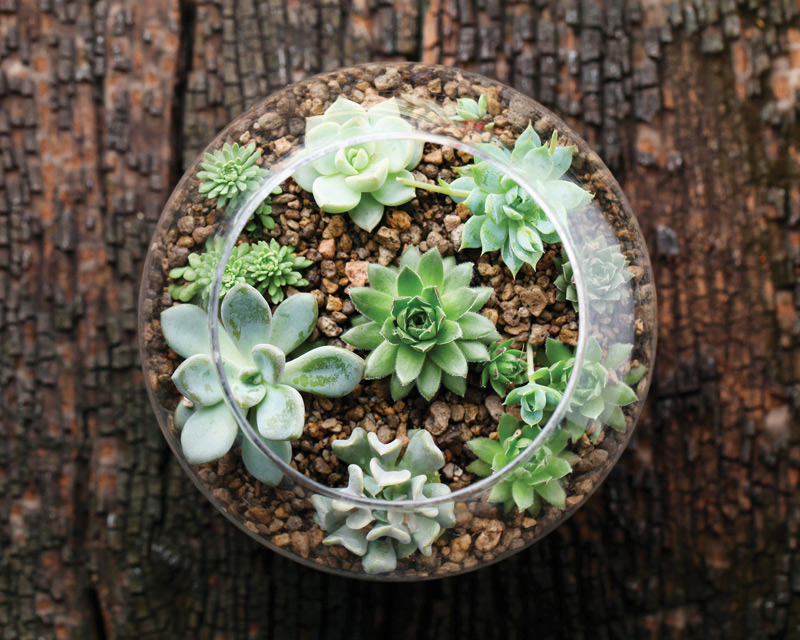BY JOSIE SEELIGSON
Living gifts that perpetuate health and productivity are the ultimate in both sustainability and pleasure. Plants help improve air quality both indoors and out, and keeping green plants around is a surefire way to fend off winter blues by bringing living indoors. This holiday season, pass on a piece of life to your favorite nature lovers.
 Living holiday trees
Living holiday trees
Pine aroma infuses many homes during the holidays, as does the tradition of selecting cut trees, then decorating and admiring them. But after a few weeks, their green needles turn brown and dry, littering the floor below and leaving a trail out the door when the spent body is dragged to the curb. It doesn’t have to end this way.
Some local nurseries sell potted varieties of pine or cypress trees, either as alternative to cut trees or in addition to them. If you add a simple bow or an ornamental tag, these can also make fantastic living gifts. The tree can stay inside for the holidays, then bed down outside to keep growing. If a yard doesn’t have enough space, many local schools, playgrounds, baseball fields or other community centers need shade, so these trees can also help spread canopies for others. If you donate the tree, just make sure that there’s some form of irrigation/watering in its new home to keep it alive.
When purchasing living holiday trees, select a variety suited to this region’s climate and soil. Ask for Japanese black pine, Aleppo pine, Deodora cedar, Arizona cypress, bald cypress, Montezuma cypress or Italian stone pine. Keep the tree outside in its pot with water and sunshine until you want it inside — then know you have about two weeks with it indoors before it needs to go outside again. While indoors, keep its soil moist and the tree a good distance from fireplaces or other heat sources.
Later, when you plant it in the ground, dig the hole about two to three times as wide as the container and the same level as the root ball—be certain not to cover the root flare on the base of the trunk when planting, as this slowly suffocates a tree. If in doubt, err on planting trees a bit higher than too deep. Allow for growing space—some of these trees can reach 40-50 feet tall and 30-40 feet wide when mature. And keep it watered. Some, like the Montezuma cypress, can grow at rapid speeds with abundant water, especially if placed next to a water source like a pond, riverbank or even an underground leak, so you may get to enjoy a mature tree in rapid time.
Living indoor worlds
If you want to gift an easy-to-care-for indoor plant, terrariums may be a great choice. These tidy tabletop greenhouse gardens can be bought fully assembled (try Shades of Green), but can be pricey. They also can be fairly easy and fun to make yourself. Keep an open mind here; you can use all sorts of interesting glass containers you may already have on hand, like old vases, mason jars or fishbowls whose occupants swam off to that bowl in the sky. You can also treasure-hunt glass containers from thrift or wholesale stores.
Within these containers of varying sizes, you can first build a little plant world — simple or elaborate — and next have the option to personalize it in all sorts of ways. At the base of the glass container, start with a layer of small rock material—pebbles of any kind, recycled glass nuggets, aquarium gravel, etc. These form a false drainage layer to settle water so plants don’t flood. The depth of this layer should be proportional to the overall height of the container, usually 1/2 to 2 inches deep to accommodate roots. Next, add a thin layer of activated charcoal crumbles or shards (ask for at your local nursery) to reduce fungi, bacteria and odors. On this, add potting soil appropriate for your plant types.
Due to varying soil and watering needs, it’s best to separate terrariums by plant type; keep succulents and cacti together, ferns and tropical plants together (for example, succulents need a sandier mix, ferns need rich potting soil). Put in enough soil so plants can fit cozily, yet still have room to grow. Select small plants that fit inside the container and won’t get too tall. Remove plants from their pots and gently break up the soil ball to get to roots. It’s fine to carefully separate multiple stems and trim roots if needed, as they can grow back. Make a small well in the soil, plant the roots, then cover and press soil up to plants’ bases. Leave a bit of elbow room on container edges for plants to stretch out.
Set a top layer of moss or pebbles, and you now have a lovely little garden world. You can stop here, or depending on your personality or the recipient’s, take it a step further by creating a scene within the little plant world. If your recipient loves horses, hippos or wildlife, purchase tiny figurines at toy or hobby stores to place among sticks and rocks collected outside. Or raid a kid’s old toy stash for small cars or action figures or even a tool cabinet or kitchen drawer depending on theme — no rules in creativity!
Wipe down any dirt from the glass walls for a clear view inside, and give it a couple of shots of water as a holiday toast; do remember they are lightweights and don’t need much. Monitor the terrarium’s water needs based on how dry the soil is. If your glass container has a lid, watch for condensation droplets on the ceiling, which means excess water needs to evaporate; just open the lid for a bit. If a leaf or plant wilts or dies, remove it from the terrarium to maintain ecosystem health. Also, keep in mind that terrariums are essentially little greenhouses, and direct sunlight through glass traps heat and scorches plants, so place them in indirect light.
And most of all, let these living gifts sustain your own life joy and help replenish it in others.









0 Comments